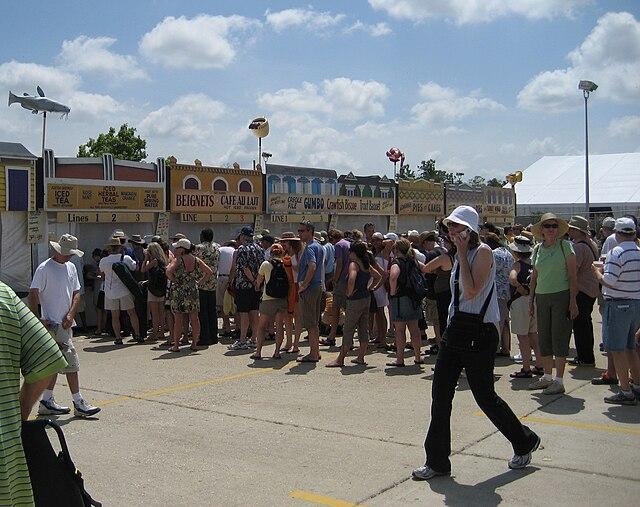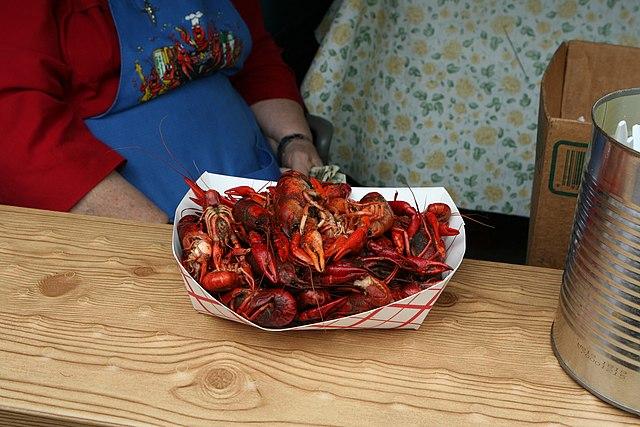88 13.1: Overview of Unique Characteristics of Temporary Foodservice Events
13.1 Overview of Unique Characteristics of Temporary Foodservice Events
Louisiana’s Festival Culture

https://commons.wikimedia.org/wiki/File:JazzFest5May07BegnietsLines.jpg
Compared to other U.S. states, Louisiana has more festivals per capita, with more than 400 festivals annually, celebrating anything from culture and heritage to music and food. Some of the famous Louisiana Festivals include the New Orleans Jazz and Heritage, the New Orleans French Quarter Festival, the Ponchatoula Strawberry Festival, and the Natchitoches Christmas Festival of Lights. Such celebrations bring excellent opportunities for food entrepreneurs, along with the increasing popularity of food trucks and other temporary foodservice businesses. Temporary foodservice businesses, however, also come with unique food safety risks that are very different from permanent brick-and-mortar restaurants.
The state’s distinctive food culture is a key draw for tourists. In 2018, 51.3 million visitors spent $18.8 billion in Louisiana, with 20% of tourists specifically motivated by culinary pursuits. In addition, in 2013, the Louisiana Office of Tourism surveyed 1,251 individuals and determined 43% came or would come to a Louisiana festival specifically for the food experience. Most Louisiana festivals feature distinctive local foods — for instance, the Zwolle Tamale Fiesta, Breaux Bridge Crawfish Festival, and Scott Boudin Festival each center on distinctive regional foods. Yet, the transient nature of these operations, combined with distinctive environmental issues and limited resources, could potentially lead to food safety hazards. These hazards need to be conscientiously watched and addressed by all state and local public health entities. Although food is a primary focus at most Louisiana festivals, most festivals are not legally required to have formal food safety inspections. Only the New Orleans Jazz and Heritage Festival has food safety inspections mandated under Louisiana law.

https://commons.wikimedia.org/wiki/File:Boiled_Crawfish.jpg
Environmental Challenges
These shortcomings may contribute to food safety concerns. Events held outdoors expose food to the following elements and environmental factors which may cause unsafe food:
Dust
Flies
Fluctuating temperatures
Weather conditions which can increase bacterial growth or introduce contaminants
Research conducted at the New Orleans Jazz and Heritage Festival revealed the presence of flies was one of the most common non-critical violations, accounting for 25% overall of all non-critical violations between 2017-2019. To combat the presence of flies, festival stakeholders may consider frequent waste management, pest control prior to the event, or the use of screens in food booths.
Resource & Equipment Limitations
Temporary foodservice operations frequently lack the infrastructure found in permanent establishments. Regarding food safety, limited access to potable water, scarce handwashing facilities, restricted storage space, and insufficient refrigeration create continual challenges for proper food safety standards. Research in North Carolina found 88% of food vendors were noncompliant with at least one food safety risk factor, and 37 establishments violated cooking and proper holding temperature guidelines.
High Volume, Fast Paced Environment
Fair and festival events typically require temporary foodservice establishments to serve large numbers of customers in shortened amounts of time. This pressure may lead to shortcuts in proper food handling and food safety practices, especially when food vendors are understaffed and faced with equipment limitations. Large crowds combined with shortened time to serve, and the fair or festival atmosphere may create an environment where proper food safety practices are easy to overlook in order to prioritize speed and customer satisfaction.
